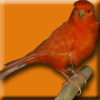|
 Canary-Colorbred Family - Finch Nick Names - Red Canary, Red Factor Canary, Red Factor Crested Canary, Red Lipochrome Colour Canary, Clear Red Canary, and Colourbred Canary. Description - Red Factor Canaries are a highly prized due to their brilliant orange (sometimes creamsicle) coloring. Most (probably all) Red Factor Canaries require special food to maintain their amazing coloring. If they are not fed the special food they will start to turn yellow after they molt. Temperament - Like all Canaries Red Factor Canaries usually don't like to be touched. It is possible to hand tame some Canaries, but it takes a tremendous amount of effort. Canaries are teritorial and usually do not like sharing their cage and rarely if ever need companionship. Sexing - It is difficult to determine the sex of the Canaries sometimes. With that said usually female Canaries have 3 evenly lengthed toes, while middle toe of male Canaries is usually longer than the two outside toes. Males also usually have flatter heads, are more colorful, and sing. Femails tend to have rounder heads, are plainer, and chirp. It is not unusual for a family to believe they have a male Canary until they find an egg sitting in their "male canary's" cage. Origin - Colourbred Canaries original origins are from the wild canaries of the Canary Islands. The name "Red Factor" is commonly used for all red colored Canaries. Colourbred Canaries were bred in captivity and do not occur in the wild. Trainability - NA. Loudness - NA. Diet: Canaries have very high metabolism. Your canary could starve to death within twenty four hours if your canary doesn't eat. Canaries should eat about half grains and half vegatable with some fruits (about 5%). Never feed any Canary anything with caffiene as an ingredient (like chocolate) and dairy products are a bad idea. Maintaining the color of colorbred canaries often requires feeding foods specifically designed to keep your canary red. Simply feeding your canary things like cayenne pepper and paprika often helps your keep their color. Some people use a carotenoid concentrate to bring out the red in your canary's plumage. Remember that there is a risk to your canary's liver and kidneys if too much of the carotenoid concentrates is fed. Most breeder believe that there is no health risks associated with carotenoid concentrates, as long as the doses are administered in the specified quantities and are not fed to your canary all year round. Color-feeding is needed slightly before and during the annual summer molt only. Desired Cage size - Your canary needs a relatively large cage because canaries are very active. They love to fly so there should be lots of perches throughout the cage. 20"X20"X26" (length X width X height) Length: 5-6 inchesLife span: 10-14 years |